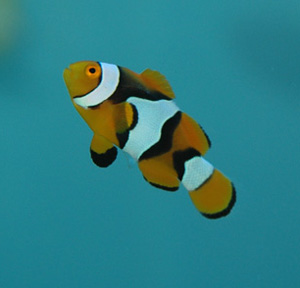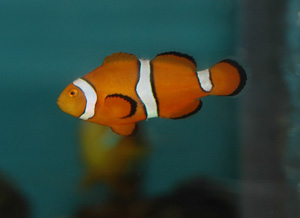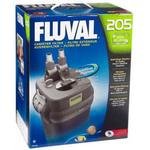Percula Clownfish - Amphiprion percula
The common Clownfish is found widespread throughout the tropical Indo-Pacific.
Maximum Size: Up to 3.1"
Minimum Tank Size: 30 gallons or larger
Care Level: Easy this a good fish to use in new tanks to help cycle the water etc. This is one of the easiest fish to maintain.
Tank Conditions: - Temperature 72-78°F; Specific gravity: 1.020-1.025; pH 8.1-8.4
Color: Orange, White - black outline
Temperament: Peaceful - may be semi-aggressive toward other clownfish
Reef Compatible: Yes
Diet: Omnivore - will take both meat and plant matter. Feed a varied diet of chopped shrimp, brine shrimp, chopped squid snd clams as well as flake food and plant matter that is used to feed herbivores.
Habitat: Provide with plenty of hiding places and live rock growth for grazing on. Clown fish usually thrive with anemones, however take note that you should look for anemones that are native to the indo-pacific region since these are from the clownfish natural environment.
 Percula clownfish is the most commonly seen Clownfish in the hobby. Its body is bright orange with three vertical white bands edged in black. All fins are also edged in black. Percula clownfish is the most commonly seen Clownfish in the hobby. Its body is bright orange with three vertical white bands edged in black. All fins are also edged in black.
They possess the unique ability to hide in an anemone without getting hurt. They have a slimy coat similar to that of the anemones, which do not identify them as enemies, which helps to protect them from predators. It may also help the anemone get food as Clownfish adds activity around the food-searching tentacles. This relationship is called symbiosis, though it has been disputed whether the anemone benefits from the Clownfish at all. Anemone's are not recommended for beginning aquarists, but if one chooses to keep anemone's with Clownfish, at least one anemone should be provided per Clownfish in the tank.
An interesting note is that if you maintain two clown fish, the dominate fish will become a female and the the other will stay male.
True Percula Clownfish:
- It has 10 (rarely 9) dorsal spines.
- It often has black edged borders of varied widths around its white bars.
False Percula Clownfish:
- It never has the black edged borders around its white bars.
- It has 11 (rarely 10) dorsal spines.
- The spinous (anterior) part of the dorsal fin is taller.
Compatibility: Clownfish are generally compatible with most other fish. They should not be housed with groupers, sharks, lionfish, moray eels or rays and there can be a problem if housed with triggerfish and certain wrasses.
|





 Percula clownfish is the most commonly seen Clownfish in the hobby. Its body is bright orange with three vertical white bands edged in black. All fins are also edged in black.
Percula clownfish is the most commonly seen Clownfish in the hobby. Its body is bright orange with three vertical white bands edged in black. All fins are also edged in black.